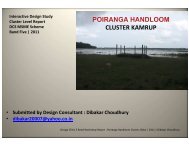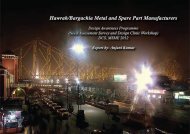Bamboo Incense Stick Cluster, Nalbari - Design Clinic Scheme
Bamboo Incense Stick Cluster, Nalbari - Design Clinic Scheme
Bamboo Incense Stick Cluster, Nalbari - Design Clinic Scheme
Create successful ePaper yourself
Turn your PDF publications into a flip-book with our unique Google optimized e-Paper software.
<strong>Design</strong> Audit - Unit 1<br />
Topic<br />
Observations<br />
Possible design solutions<br />
Product<br />
Process<br />
Packaging<br />
Storage<br />
• <strong>Bamboo</strong> sticks are not clean - numerous exposed fibres<br />
• The application of masala along the length of the sticks is<br />
erratic and varying<br />
• Cracking of the applied masala during the drying process.<br />
• Rolling technique used results in an uneven shaped incense<br />
stick. Also, the masala coats the palm very often, leading to<br />
further unevenness.<br />
• The surface of the worktable is coated with the masala<br />
at regular intervals, and is not cleaned frequently, causing<br />
stickiness and unevenly rolled incense sticks.<br />
• As the BISP are wholesalers, finished sticks are bundled into<br />
half kg packs and tied with twine. Sacks of 40 kg are<br />
transported to Guwahati.<br />
• Cracking along the areas covered by the twine<br />
• Storage of raw material: Most raw material is stored in a<br />
large shed with bamboo walls and an asbestos roof. Materials<br />
are stored close to the dirt floor, sacks spilling over on floor<br />
and designated areas for specific material.<br />
• Finished incense sticks are stored in the main work shed, along<br />
the walls, on sheets spread on the dirt floor.<br />
• Quality checks during the stick making process, to discard<br />
fibrous sticks<br />
• Mark area for coverage prior to rolling, perhaps by dyeing to a<br />
particular length<br />
• Correct proportion of ingredients, including water, to achieve<br />
best consistency<br />
• Use of trays to dry ready sticks in. Also drying in a shaded<br />
area away from direct sunlight will prevent excessive drying<br />
and consequent cracking<br />
• Can try method of rolling similar to that in Vietnam - by using<br />
a flat piece of wood instead of the palm of the hand. This<br />
will help maintain a regular surface and a better shape. Also, it<br />
requires very little expenditure. Training using this technique, if<br />
acceptable, can begin immediately.<br />
• Surface of worktable can be cleaned regularly - providing a<br />
scraper, such as metal sheet, will make this easier.<br />
• In case of plans to enter the retail market, appropriate<br />
packaging and graphic design input, will be required<br />
• Use of a wider linear material such as a leaf prior to tying - this<br />
will help reduce the amount of force applied on a particular<br />
area, leading to cracking<br />
• Need to store powdered raw material further off the floor. Can<br />
construct raised platforms for each type. This will automatically<br />
cause designated areas of storage for different materials.<br />
• Finished sticks can be stacked on raised and shelved platforms<br />
and not more than two or three bundles high. The current<br />
method of stacking upto 10-12 bundles high, causes cracking<br />
in the bottom most bundles.<br />
16<br />
N.A.S for <strong>Bamboo</strong> <strong>Incense</strong> <strong>Stick</strong> <strong>Cluster</strong>, <strong>Nalbari</strong> | 2013 | Mridul Mitra, <strong>Design</strong> Consultant | Email: mridul.mitra@gmail.com







